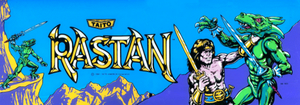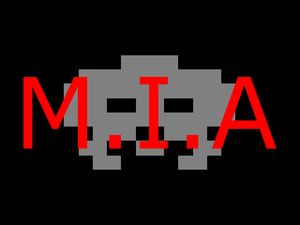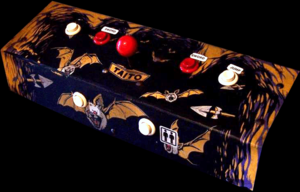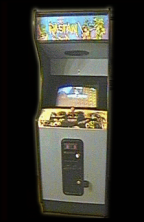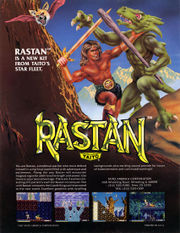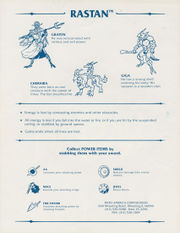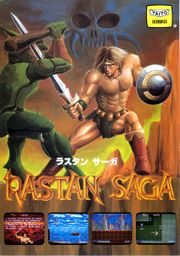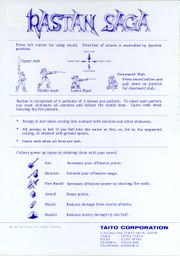Lost In Translation/Rastan
| Rastan | |
|---|---|
| Manufacturer | Taito Corporation Japan |
| Released | 1987 |
| Control Method |
8-way Joystick 2 Button(s) |
| Main CPU | 68000 (@ 8.000 MHz) Z80 (@ 4.000 MHz) |
| Sound CPU | Mono YM2151 (@ 4.000 MHz) MSM5205 (@ 384.000 kHz) |
| Video Details |
Raster (Horizontal) 320 x 240 pixels 60.00 Hz 8,192 Palette colours |
| Screens | 1 |
| ROM Info | 16 ROMs 1,572,864 bytes (1.50 MiB) |
| MAME ID | rastan · rastanu · rastanu2 · rastsaga |
About The Game
Rastan is an hack and slash arcade video platform game in which a single player guides a barbarian hero through a number of fantasy-themed levels, fighting through swathes of mythological fantasy creatures, including orcs, skeletal warriors and multi-headed hydra.
More powerful weapons can be picked up, as well as bonus items that can increase the barbarian hero's health and give increased protection against enemy attack. Players should be wary that some collectable items are cursed and will have a detrimental effect on the hero's health and performance. Unlimited continues are available throughout the game.
Trivia
Released in March 1987.
This game is known in Japan as "Rastan Saga".
Rastan was inspired by the 'Conan the barbarian' saga novels, by Robert E Howard. In the background of the first stage, giant stone statues can be seen that bear more than a passing resemblance to the statues that featured in 'The Lord of The Rings - Fellowship of the Ring'. While the film appeared several years after Rastan, the famous LotR concept artwork that featured in the deluxe edition of the book had been available for some time.
The main character, Rastan, appears as a selectable character, 'Miracle Rastan', in "Champion Wrestler".
The game contains several bonus items that are not normally dropped by enemies : A golden armature, a brown scroll and a yellow scroll. Graphics for these can be seen in the tile-sets and modifications to game's data tables can cause them to be dropped. The golden armature acts like the existing armature, the scrolls do nothing.
The game contains a built in test mode, activated by the value of two bytes towards the end of the code ROMs. Invincibility can be selected, causing 'NO-HIT' to be displayed at the bottom of the title screen. The starting level can also be modified.
The game forbids the initials 'SEX' on the high-score table. If you try, they get changed to 'AHA'.
Pony Canyon / Scitron released a limited-edition soundtrack album for this game (Kyukyoku Tiger : G.S.M. Taito 2 - D28B0008) on 21/11/1988.
Zuntata Records released a limited-edition soundtrack album for this game (Zuntata History L'ab-normal 1st - ZTTL-0038) on 01/04/1999.
Updates
"Rastan Saga" has some differences :
- In the attract mode appears the intro (instead the description of the objects).
- If you waste too many time without advancing in the stage, only 2 bats will attack you (instead of 8).
Tips and tricks
- If you die on the final stage, the game ends and you cannot continue; this means that the entire final level must be completed on a single credit. In order to make this even remotely possible you should deliberately die at the end of the fifth stage while fighting the boss (a multi-headed dragon). You should then use another credit to continue and defeat the dragon with your first man (with as little damage as possible). If you cannot defeat him with the first man and little damage, kill off the remaining men and start with a fresh credit. Always go after the special weapons where possible; if special weapons run out, jumping and striking doubles the damage done with the sword. Pushing up and the jump button will jump higher than pushing the jump button alone.
- The game attract sequence does not reveal the purpose of the rod. If you are carrying it, killing an enemy of any type causes all other on-screen enemies of the same type to die.
- If you are going for a high-score, always 'pick-up' the poisons. They are worth a lot of points.
- The ring can always be obtained in the first level castle. Proceed past the 3 ropes, down the next long chain and then up the next long chain. Slowly nudge this chain off-screen and two enemies appear on the left-hand side, one of which always carries the ring.
- Chains in castles can often be traversed upwards much quicker by repeatedly jumping against a nearby wall. Others needing to be traversed downwards can be missed by jumping off and falling. The level 4 boss is virtually impossible to defeat unless this tactic is used, in order to meet him carring the hammer.
- Repeated high vertical jumps are a good method to use to 'stall', when on slopes approaching bouncing fireballs.
- Many players don't know that the 'mud' first encountered on level 2 does not actually kill you, it just causes you to sink down requiring many quick jumps to get out.
Series
1. Rastan (1987)
2. Nastar (1988)
3. Warrior Blade - Rastan Saga Episode III (1991)
Staff
- Game Designer
- Nenko Nishimura
- Game Programmers
- Yoshinori Kobayashi
- Hideaki Tomioka
- Touru Takahashi
- Hideo Kazama
- Character Designer
- Nenko Nishimura
- Art Designers
- Nenko Nishimura
- Taira Sanuki
- Seiji Kawakami
- Genya Kuriki
- Hardware Engineer
- Noboru Takeshita
- Hardware Designer
- Masahiro Yamaguchi
- Music Composers & Sound Effects
- Naoto Yagishita
- Masahiko Takaki
- Art Advisor
- Junji Yarita
Cabinet and Artwork
Ports
- Consoles
- Sega Master System (1988)
- Sony PlayStation 2 (2005, "Taito Legends")
- Microsoft XBOX (2005, "Taito Legends")
- Computers
- Tandy Color Computer (1988, "Warrior King")
- MSX2 (1988)
- Commodore C64 (1988)
- Sinclair ZX Spectrum (1988)
- Amstrad CPC (1988)
- PC [MS-DOS, 5.25] (1990)
- PC [MS Windows] (2005, "Taito Legends")
Soundtrack Releases
| Album Name | Catalogue No. | Released | Publisher | Comments |
|---|---|---|---|---|
| Z-REPLICA Vol.3 Legend THE RASTAN | ZTTL-0029[1] | 1998-09-21 | Zuntata Records | CD version. |
| Electroid : Rebuilt | N/A[2] | 2005-01-01 | N/A | CD version. |
External Links
- Sinclair ZX Spectrum version of Rastan at the World of Spectrum
References
- ↑ Z-REPLICA Vol.3 Legend THE RASTAN (CD) at the VGMdb
- ↑ Electroid : Rebuilt (CD) at the VGMdb


